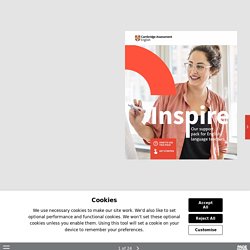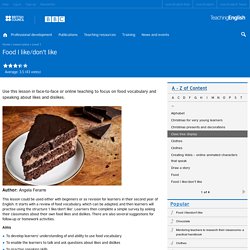

Adir Ferreira Idiomas - Teacher Support Pack - Global - 2. Cookies We use necessary cookies to make our site work.

We'd also like to set optional analytics cookies to help us improve it. We won't set optional cookies unless you enable them. Using this tool will set a cookie on your device to remember your preferences. For more detailed information about the cookies we use, see our . Cookie Information PageTiger View Policy cookie-preferences This cookie is used to remember your cookie preferences. Remembers your device between visits. These cookies allow you to temporarily view a document that is not yet published. These authentication cookies are required when viewing a restricted document.
Used to remember your email address on pages that require authentication. PTIAccessibility* Chocolate cake. Food I like/don't like. This lesson could be used either with beginners or as revision for learners in their second year of English.

It starts with a review of food vocabulary, which can be adapted, and then learners will practise using the structure 'I like/don't like'. Learners then complete a simple survey by asking their classmates about their own food likes and dislikes. There are also several suggestions for follow-up or homework activities.
Aims. English ESL past simple board game worksheets - Most downloaded (35 Results) Simpsons Boardgame Daily Routine By Lili27 The game is played in groups from 2 to 4.

Each player chooses one character (Lisa, Homer, Bart or Marge).The objective of the game is to ... Simpsons Boardgame Daily Routine. Past Simple Regular Verbs Jigsaws - ESL Past Simple Games. Using arts and crafts arts in English lessons. Artful Storytelling. Total physical response - TPR. Where is it from?

How can I use it in class? When should I use it? Why should I use it in the classroom? A few useful variations Are there any disadvantages with using TPR? Where is it from? TPR stands for Total Physical Response and was created by Dr. How can I use it in class? In the classroom the teacher plays the role of parent. It is more effective if the students are standing in a circle around the teacher and you can even encourage them to walk around as they do the action. Vocabulary activities.
Checking Understanding. Analysis of the language consists of two sub-stages, often known as highlighting and concept checking.

Highlighting is taking the model sentence and showing, telling or eliciting what the problems are in terms of form, function, and phonology. Concept checking is checking the understanding of difficult aspects of the target structure in terms of function and meaning. Concept checking is vital, since learners must fully understand the structure before any intensive practice of form and phonology is carried out. Ways of checking understandingConcept questionsSome examplesLearning to construct concept questionsConclusion Ways of checking understanding Concept checking is normally achieved by the use of a set of questions designed to ensure comprehension of the target language, raise awareness of its problems, and to indicate to the teacher that the learners have fully understood.
The question 'Do you understand? ' Time lines to establish tenses. Target sentence: Look! Yes/no questions. Using students' first languages in the classroom. Summary: Using students' first languages in the classroom Whether it is better to use the students' first language (L1) in class or have an English-only policy is something that has been much debated and that has seen many changes of fashion over the years. It seems, therefore, that the only sensible reaction an individual teacher can take to this controversial subject is to neither accept nor reject the use of L1, but simply to search for an ideal level of its use in each individual class- maybe changing its use as the class progresses in level or changes in other ways.
Here are some tips to help you spot if you have found your own perfect level of L1 use in your classes and how to adjust the level if you haven't reached that point yet. Possible signs that there is too much L1 in your classroom 1. Possible signs that you could usefully have more L1 in your classroom 1. Ten Great Activities: Teaching With the Newspaper. Ten terrific classroom activities that use the newspaper to teach all sorts of valuable skills -- including reading and writing for meaning, map reading, media literacy, sequencing, word meaning, and math. "The newspaper is the most widely used of the media [as a teaching instrument in the classroom], the direct result of a national campaign by publishers, known as Newspapers in Education (NIE). Before the advent of NIE, newspapers tended to be used only by secondary school social studies teachers in two-week units or for Friday current events sessions.
Now, however, newspapers are used throughout the school year in every area of the curriculum. " Those are the words of Nola Kortner Aiex, author of Using Newspapers as Effective Teaching Tools. Indeed, the news is more a part of the school curriculum than it ever was -- for many reasons. Read and write for meaning. Read a map. In what city did the story take place? Understand the media. Arrange in sequence. Motivating speaking activities for lower levels.
Planning time has been shown to increase production in speaking tasks. Lower level learners often find it especially difficult to speak spontaneously, so these activities incorporate 'thinking time' during which learners can prepare for speaking by planning what they are going to say, and asking the teacher or using a dictionary to look up missing vocabulary. The following activities are relatively short, with minimal materials preparation time for the teacher. They are designed for use as a warmer or a filler in the middle or at the end of a class. 1. Definitions lists This activity is good for activating existing vocabulary or revising vocabulary studied in previous lessons.
Procedure Choose a vocabulary topic (this can be vocabulary you have recently studied or a topic you want to introduce). A faster-moving, fun alternative to this activity is a team game. 2. 3. This is a variation on the above activity and is great for practising adjectives. 4. 5. TeachingEnglish. Reflective teaching Exploring our own classroom practice. English speaking skills practice.